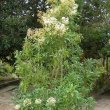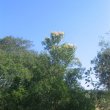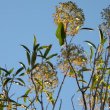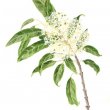Nuxia floribunda
| Botanical Name | Nuxia floribunda |
|||||||||||||||||||||
| Family | Buddlejaceae - The buddleja family. |
|||||||||||||||||||||
| Pronunciation | NUKS-ee-uh flor-ih-BUN-duh |
|||||||||||||||||||||
| Common Name(s) |
English: Forest Elder
Afrikaans: Bosvlier
IsiXhosa: iNgqota; isiKhali
IsiZulu: ingobese; isanywana; umKhobeza
Sesotho sa Leboa: motlhabare
Tshivenda: mpupumwa; Mula-notshi
|
|||||||||||||||||||||
| Plant Group |
|
|||||||||||||||||||||
| Plant Size |
|
|||||||||||||||||||||
| Position |
|
|||||||||||||||||||||
| General Information |
|
|||||||||||||||||||||
| Specific Information | This visually appealing specimen has a shapely crown and copious, sweetly scented flowers. Although it can reach up to 25 m in the moist environment of a sub-tropical forest, it is more usually a small tree of 3 - 10 m. The leaves of this tree hang gracefully and tremble in the slightest breeze. A good garden species with a non-invasive root system but they need plenty of water and cannot tolerate frost. |
|||||||||||||||||||||
| Ad Break | ||||||||||||||||||||||
| Flowers | ||||||||||||||||||||||
| Description | tiny flowers in large branched clusters |
|||||||||||||||||||||
| Season |
|
|||||||||||||||||||||
| Colour |
|
|||||||||||||||||||||
| Growth Rate |
|
|||||||||||||||||||||
| Plant Uses |
|
|||||||||||||||||||||
| Distribution and Habitat | from the Western Cape to the Eastern Cape, KwaZulu-Natal, Mpumalanga and Limpopo, north to Malawi and Zambia, growing along riverbanks |
|||||||||||||||||||||
| Planting Suggestions | Mulch well and water regularly throughout the year for optimum growth. The forest elder can be planted near paving, walls and buildings. This is a forest species and will need a regular supply of water for it to grow and flower to its full potential. The old method of digging a deep hole and filling it with soil and compost has resulted in many trees failing to thrive, dying, rotting at the base or worse still, falling over in later years due to poor root development. Refer to the following sites for the best method of planting trees: International Society of Arboriculture: New Tree Planting Tree People: Plant the right way For those of you who have a clay problem try: |
|||||||||||||||||||||
| Medicinal Uses | The bark is used by the Zulu as a strengthening medicine after a kraal (village) member has passed away, while in other parts of Africa the leaves are recorded being used to treat coughs, colds, influenza, fevers, indigestion, infantile convulsions as well as in rituals. |
|||||||||||||||||||||
| Ad Break | ||||||||||||||||||||||











Discuss this plant
Share knowledge, ask a question or give an experience.